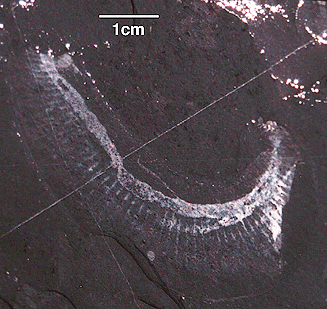
Ottoia prolifica, showing muscle bands and gut.
Ottoia is a priapulid worm found commonly in the Burgess Shale. Image copyright © 1995 by Andrew MacRae
| Palaeontology | ||
| Life | Lagerstätten |
| Trace Fossils | ||
| Evolution | Life | Systematics |
Life |
Paleontology |
 Ottoia prolifica, showing muscle bands and gut. Ottoia is a priapulid worm found commonly in the Burgess Shale. Image copyright © 1995 by Andrew MacRae |
As far as fossil remains go, almost always, only scraps of bone or shell or a few carbonized leaves are all that remain of past organisms. Too often the soft parts decompose, and even the hard parts degrade.
In some exceptional instances however, usually anaerobic environments, or a sudden mudslide or volcanic eruption, organisms are buried before their bodies can be broken down by bacteria, or consumed by scavengers. Eventually their bodies are carbonized or mineralized, and so even soft-bodied creatures become fossilized. Such environments provide a unique, rare and precious window to the past.
These extraordinary fossil deposits, where organisms are so well preserved that even their soft parts remain as carbon films, are referred to as Lagerstätten, a German word meaning "deposit places". These are geological fossil deposits that are rich with varied, well-preserved fossils, representing a wide variety of life from a particular era. These spectacular fossil deposits represent a window into the past, a kind of "snapshot" of the type of organisms (hard and sometimes soft-bodied) that lived at that particular time and place.
| Some Lagerstätten | Location | Period/Epoch | Age of Deposits |
| Chengjiang Maotianshan Shales | Yunnan Province, China | Early Cambrian | 535 million years old |
| Burgess Shale | British Columbia, Canada | Middle Cambrian | 530 million years old |
| Kaili Formation | Guizhou Province, China | Middle Cambrian | 513 million years old |
| House Range | Millard County, Utah, USA | Middle Cambrian | 507 million years old |
| Orsten | Sweden | Furongian | 500 million years old |
| Hunsrück Slates | Bundenbach Germany | Early Devonian | 370 million years old |
| Mazon Creek | Northeastern Illinois, USA | Late Carboniferous | 300 million years old |
| Holzmaden | Württemberg, Germany | Early Jurassic | 190 million years old |
| Solnhofen Limestone | Bavaria, Germany | Late Jurassic | 150 million years old |
| Auca Mahuevo | Patagonia, Argentina | Late Cretaceous | 80 million years old |
| Green River Formation | Wyoming and Colorado, USA | Eocene | 50 million years old |
| Messel Oil Shale | Hessen, Germany | Eocene | 49 million years old |
| Ashfall Fossil Beds | Nebraska, United States | Miocene | 10 million years old |
| Rancho La Brea | Southern California, United States | Late Pleistocene | 20,000 years old |
General: Looking Back Through Lagerstätten - good intro - with links. Lagerstätten - very brief intro - has a useful table listing the main Lagerstätten
Specific (this list is incomplete...) Burgess Shale fossils - by Andrew MacRae - short intro to Burgess Shale and representative fossil organisms - best on the Web; Mazon Creek Fossils - the Illinois State Museum Mazon Creek homepage; The Solnhofen Limestone of Germany; Chengjiang Fossils - I don't like commercial fossil sites, but this one has some nice photos; 'Orsten' Research and Dieter Waloszek's View of Arthropod and Crustacean Phylogeny - includes info on arthropods from this important but less well-known Furongian Lagerstätten

|

|
|
The Fossils of the Burgess Shale - by Derek E. G. Briggs |
Solnhofen - a study of Mesozoic Palaeontology by K. Werner Barthel, S. Conway-Morris, and N. H. Swinburne |
page created 19 June 2001; last modified MAK111005
checked ATW050504